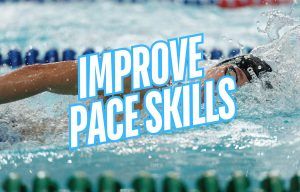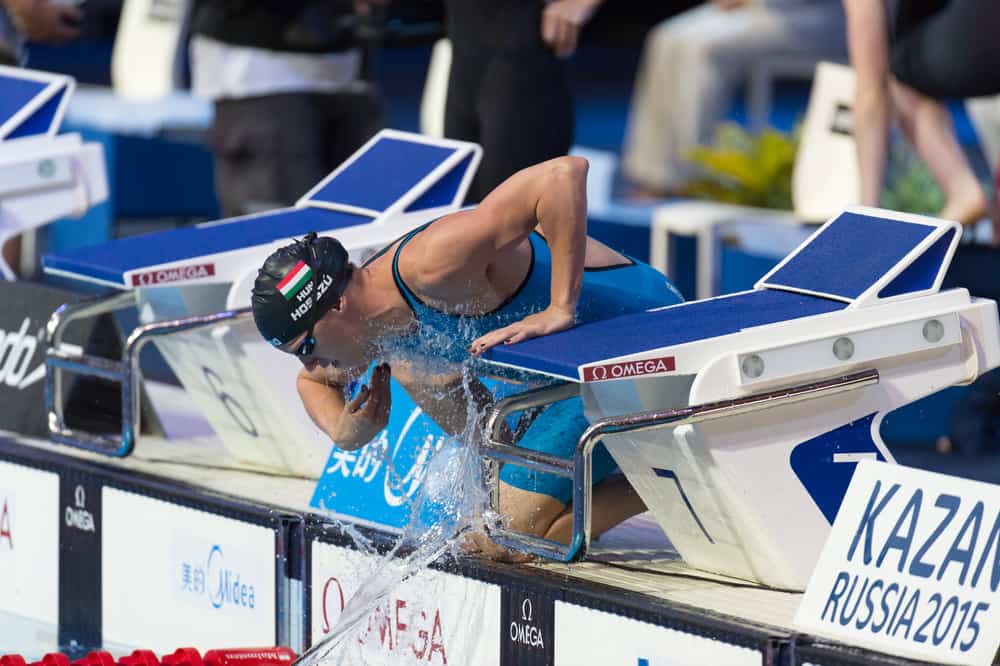
How to Improve Your Pacing Skills
Looking to up your pacing skills in the pool? Here are some actionable pacing tips and tools to help you master pace and your performance on race day.

Standing on the blocks you stare down the flat, cool water, and take a big breath. The training has been done. You made it to all the available workouts. Did extra core work on your own. And even started taking your nutrition seriously.
And yet, you feel your mind racing away from you:
The swimmer in lane 4 looked like he was really taking it easy in prelims. Is he going to dust me tonight? That last sprint during warm-up didn’t feel as good as I did this morning. Am I going to swim slower in finals? This is it, this race is the sum of who I am as an athlete, and if I don’t at least destroy my PB it’s all going to have been for nothing.
Yowza.
In moments like this our anxieties take over, leading to a situation where you have difficulty performing in a manner that reflects the awesome training you have done to date. A situation where the worst of your fears comes to pass… you choke.
We’ve all been there at some point.
Where our thoughts ended up dictating our performance. Where physically we were as ready as ever but our brain-noodle-thing simply didn’t want to keep up.
Here is how being a more mindful swimmer can help you relax, stay focused, and perform better in the moments that matter most:
What is mindfulness, exactly? Is it sitting atop a mountain, in a yoga pose, face to the sun, quietly humming in hippie gear? Not quite.
It’s a tool that you use to increase awareness by paying attention to the present moment on purpose. Mindfulness allows you to take control of what is going on in your head so that you can better perform with your body.
It can help us chill out when we are getting too anxious. In the days, hours and minutes leading up to the big race it’s natural to start to get a case of the butterflies. This nervousness can be good—to a degree. It’s when you start to get stressed and too caught up in the outcome that problems arise. Instead of focusing on the preparation and the moment you lose a sense of perspective and focus. In other words, you choke.
It keeps us calm in the face of adversity. When done properly mindfulness helps you to react to unfolding events, moment by moment in a non-judgmental manner. In other words, you don’t blow your lid or get overly frustrated when things don’t go your way. It’s a chill form of resilience.
Helps us stay on top of the self-talk going through our head. It’s bad enough having someone else tell you that ya stink, but when it’s the voice between your ears its exponentially more deflating. For a moment think about all of the self-talk you engage in over the course of the day, and consider how much of it is awful. Some of the more popular ones: “I suck. I’m no good at this. I’ll never be a fast swimmer.” Mindfulness puts a muffler on that self-talk by blocking everything out.
Helps dial down our perfectionism. “All-or-nothing” thinking is rampant. We feel like things have to be executed exactly to standard, or not at all. As a result, we end up doing a lot of stop-and-go with our training/racing when we don’t reach the impossible standards we set for ourselves. Particularly during bouts of hard training mindfulness can give you the perspective to be more consistent so that when you have one bad workout it doesn’t spiral into a bender of missed practices and Doritos.
You don’t need me to tell you that getting too anxious before a big race or really tough workout can be a problem. (But I’m going to anyways.)
Overly worrying about the outcome can yield negative performance benefits, as shown by a study in the UK that found simply calling a trial a “competition” versus calling it “practice” ended up causing increased cognitive anxiety (a.k.a. “choking”).
Fortunately, there is a vast amount of research that backs up the claims behind mindfulness:
Okay, okay—so the stuff works.
How do we do it and implement it into our training so that we can mentally live life a little more Zen and a little less like a hyperactive chicken on half a case of Red Bull?
Like anything, practicing mindfulness takes, well, practice! And the more you do it the better you get at it.
It starts with focusing on your breath, and then as you get better at it you can move on to focusing on emotions and thoughts.
Here are two methods you can use to get into the mindfulness habit:
The simplest way to practice mindfulness is by focusing on your breathing. No special handbook, yoga mat or incense candle required. Just you and focusing on your breath.
Find a quiet spot, turn off the phone and turn down the television and your siblings and breathe. Focus on the inhalation and the exhalation of your breath.
Long, deep breaths. Start with 1-2 minutes and work your way up from there. You can use this “trick” before a big event or big effort as well to help slow your heart rate and dial back anxiety.
Best of all is that it’s highly versatile: you can do it in the back of the car, on the couch, in bed at night, when you are about to take off on a plane, or standing before the whiteboard while coach outlines the ridiculous set to come later in the workout.
Doing a quickish body scan is another versatile and convenient mindfulness technique.
Sitting in a chair or lying down (careful you don’t doze off…) focus on how different parts of your body all feel while sitting or standing. How your feet feel against the floor. How your head feels against the pillow. Your shoulders touching the chair.
When you catch your thoughts drifting away (what is for dinner?) bring your attention back. Here is a link to a 5-minute body scan video that you can use to guide you (also includes 3-minute and 10-minute scripts as well).
Mindfulness work is a tool that you can add to your training and competitive arsenal in order to help you stay in a positive, calm and focused state of mind. In moments of stress it can help you regulate your emotional level to the situation at hand.
Will you always need it? Probably not, there will be moments where you are mentally ready to absolutely rock and roll.
But for the moments where you feel like you need some perspective, to tone down the butterflies, and to enjoy the moment, throw some mindfulness training at it.

Olivier Poirier-Leroy Olivier Poirier-Leroy is the founder of YourSwimLog.com. He is an author, former national level swimmer, two-time Olympic Trials qualifier, and swim coach.
✅ Free shipping on Orders over $49
✅ Price Match Guarantee
✅ Best selection of gear for training and competition
✅ Fast and Easy Returns

“This is the best book I have ever seen concerning mental training.” — Ray Benecki, Head Coach, The FISH Swim Team


Looking to up your pacing skills in the pool? Here are some actionable pacing tips and tools to help you master pace and your performance on race day.

Looking for tips on how to use a drag chute for improved swim performances? Read on for some proven tips, sets, and pointers for training with a chute.

Ready to take your swimming to the next level? Here are seven ways that a drag chute can help you become a better and faster swimmer.

Wondering if a swim bench can help improve your swimming? Here are six benefits of swim benches for better technique, more power, and faster swimming.

Not breathing into the walls is one of the fundamental skills developing swimmers are taught. Here is how powerful a no-breath approach is for turn and swim speed. Strong training habits are something swimmers hear a lot about from their earliest days of their competitive swimming careers. The greatest hits

Drills with a swim snorkel are one of the best ways to maximize engagement and skill development. Here are five swim snorkel drills to try for faster swimming.
SITE
SHOP
GUIDES

LANE 6 PUBLISHING LLC © 2012-2025
Join 33,000+ swimmers and swim coaches learning what it takes to swim faster.
Technique tips, training research, mental training skills, and lessons and advice from the best swimmers and coaches on the planet.
No Spam, Ever. Unsubscribe anytime.
